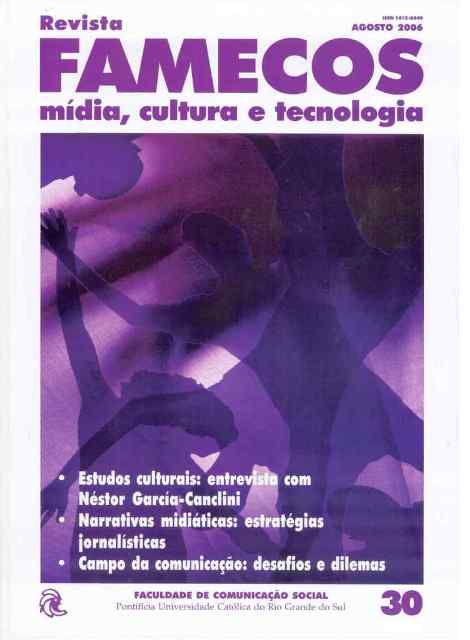The Field of Communication: its constitution, challenges and dilemmas
DOI:
https://doi.org/10.15448/1980-3729.2006.30.3372Keywords:
Communication, field of communication, scientific researchAbstract
The origin of fields of study such as Communication comes from a double movement. The first is an internal movement of science itself, which is one of convergence and overlapping of contents and methodologies, and which is increasingly noticed in the recent historical development of Social Sciences. The second is the movement of historical rupture caused by what is conventionally called the process of globalization. In the present text I follow previous reflections on the subject, to now focus on the double movement mentioned above, problematizing: 1) the meanings of the notion of field and academic field; 2) the disciplinarization that guided the birth and development of the Social Sciences and in sequence, the studies of Communication; 3) global society as a communication society; 4) the dilemmas of the institutionalization of the field of Communication in Brazil.Downloads
References
BOURDIEU, Pierre. El ofício de sociólogo. México: Siglo XXI, 1975.
______ . O campo científico. In: Bourdieu (Col. Grandes Cientistas Sociais). São Paulo: Ática, 1983.
CANCLINI, Néstor García. De cómo Clifford Geertz y Pierre Bourdieu llegaran al exilio. In: REGUILLO, Rossana y FUENTES, Raúl (coords.) Pensar las ciencias sociales hoy. Guadalajara: Iteso, 1999.
CAPPARELLI, Sérgio e STUMPF, Ida. A constituição da comunicação como campo de conhecimento multidisciplinar. I Conferência Científica da UFRGS. Porto Alegre, 1998.
FAUSTO NETO, Antonio. A pesquisa vista "de dentro de casa". In: Tensões e objetos. Porto Alegre: Sulina. FUENTES NAVARRO, Raúl (1998). La emergencia de un campo académico: continuidad utópica y estructuración científica de la investigación de la comunicación. Guadalajara: ITESO/Un.Guadalajara, 2002.
GIDDENS, Anthony. A constituição da sociedade. São Paulo: Martins Fontes, 1989.
IANNI, Octavio. A sociedade global. Rio de Janeiro: Civilização Brasileira, 1992.
______. Globalização: novo paradigma das ciências sociais. Estudos Avançados, 21, São Paulo: IEAUSP, 1994.
KUHN, Thomas. As estruturas das revoluções científicas. São Paulo: Perspectiva, 1976.
LOPES, Maria Immacolata Vassallo. Sobre o estatuto disciplinar do campo da comunicação. In: LOPES, M.I.V. (org.). Epistemologia da comunicação. São Paulo: Loyola, 2003.
LOPES, Maria Immacolata Vassallo. Por um paradigma transdisciplinar para o campo da comunicação. In: DOWBOR, Ladislau, IANNI, Octavio et al. (orgs). Desafios da comunicação. Petrópolis: Vozes, 2000.
MARTIN-BARBERO, Jesús. Comunicación fin de siglo. Para donde vá nuestra investigación? Telos, 47, Madrid, 1996.
MARTIN-BARBERO, Jesú. Decontrución de la crítica: nuevos itinerarios de la investigación. In. LOPES, M.I.V. e FUENTES, R.(comps.). Comunicación. Campo y objeto de estudio. Guadalajara: ITESO, 2001.
MORAGAS, Miguel. Ubicación epistemológica e ideológica de la comunicación. In: Teorias de la Comunicación. Barcelona: G.Gili, 1989.
MORCELLINI, Mario e FATELLI, Giovambattista. Le scienze della comunicazione. Roma: La Nuova Italia Scientifica, 1996.
MORIN, Edgar. Introdução ao pensamento complexo. Lisboa: Inst. Piaget, 1991.
MORIN, Edgar. Ciência com consciência. Lisboa: EuropaAmérica, 1986.
PRIGOGINE, Ilya. La fin de las certidumbres. Santiago de Chile: Ed. Andrés Bello, 1997.
VATTIMO, Gianni. A sociedade transparente. Lisboa: Relógio d'Água, 1992.
WALLERSTEIN, Immanuel. El legado de la sociología, la promesa de la ciencia social. Caracas: Nueva sociedad, 1999.
WALLERSTEIN, Immanuel et al. (1996). Para abrir as ciências sociais. Lisboa: Europa-América. WALLERSTEIN, Immanuel. Unthinking social science. Cambridge: Polity Press, 1991.
WALLERSTEIN, Emmanuel. Analisis de los sistemas mundiales. In: GIDDENS, A., TURNER, J. et al. La teoría social hoy. Madrid: Alianza, 1990.
Downloads
Published
How to Cite
Issue
Section
License
Copyright
The submission of originals to Revista Famecos implies the transfer by the authors of the right for publication. Authors retain copyright and grant the journal right of first publication. If the authors wish to include the same data into another publication, they must cite Revista Famecos as the site of original publication.
Creative Commons License
Except where otherwise specified, material published in this journal is licensed under a Creative Commons Attribution 4.0 International license, which allows unrestricted use, distribution and reproduction in any medium, provided the original publication is correctly cited.






